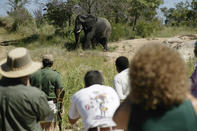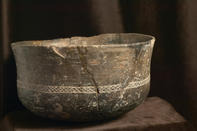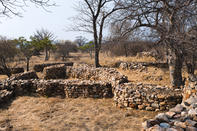Bushman Trail
As was the case throughout Southern Africa, the first identifiable human civilisation to live in the Kruger National Park was the Bushmen (or San), who emerged as a distinct culture around 20 000 years ago.

The size of this nomadic community of hunter-gatherers and the length of time they spent within the boundaries of the present-day national park are hard to determine, but their unmistakable paintings and rock art have been found at over 130 sites throughout the Kruger National Park.
There are also a couple of potential Khoikhoi rock art sites in the north of the park (the Khoikhoi, also derisively known as Hottentots, were relatives of the Bushmen who had adopted pastoralism from the Bantu tribes migrating southwards down the continent. Surveys of these rock art sites are ongoing and, in the future, several sites may be developed for tourism.
At the moment, the best way to see the Bushman heritage of the Kruger National Park is through the guided Bushman Walking Trail near Berg-en-Dal camp.
A Remarkable Bio-Diversity

Since time immemorial, wild animals have flourished in the Lowveld. The warm temperatures and regular rainfall nurtured a remarkable biodiversity, and the region supported thousands of plant and animal species. Back then, when the natural order was intact, the herds of game would drift with the seasons.
Winters were spent grazing in the well-watered foothills of the escarpment. In summer, they migrated eastwards into the dense bush of the plains. Weak and puny humans, however, have always had one big problem with the region: disease. The Anopheles mosquito, some of which carry the malaria pathogen, is endemic to the area.
Other deadly diseases are (or were) also common in the Lowveld, including nagana (sleeping sickness, transmitted by the hated Tsetse fly), anthrax, foot and mouth, dikkop, blackwater fever and several other tropical maladies. It took a very hardy type of hominin to settle among these pestilential plains. But that is not to say that the Lowveld was uninhabited.
The earliest evidence of human habitation indicates that Homo erectus, one of our evolutionary predecessors, walked the Lowveld plains of the Kruger National Park around 500 000 years ago. Early modern humans (Homo sapiens) also lived in the Lowveld, and Kruger Park archaeologists have identified over 300 sites containing stone tools dating from the Later Stone Age, between 100 000 to 30 000 years ago.
A New Kind of African

From about 4000 years ago, a new kind of African began to move down the continent in a mass migration that came to be known as the Bantu Diaspora. These native tribes originated in Western Africa, around modern-day Cameroon and the Niger Delta, and they spoke a root language called ‘Ntu’ – hence Ba-Ntu translates as ‘the people of Ntu’. But what really made them stand out were the new technologies they had adopted from travellers plying the trans-Sahara trade route that linked west Africa with the Middle East.
These new-fangled ideas included such innovations as metal work (iron smelting and casting), agriculture (sowing and reaping crops) and the keeping of domesticated animals (including cattle, goats and, later, sheep). The initial Bantu migration was probably triggered because of population pressure and climate change in their home region but, whatever caused the initial wanderlust, the diaspora soon gathered its own momentum.
Thus, armed with the Iron Age and pastoralism, the Bantu began to move slowly south; travelling in several distinct streams along the east and west coasts of Africa – slowly supplanting the Stone Age Bushman cultures they encountered en route.
The Genesis of South Africa

As the Bantu journeyed, groups split away from the main body and established settlements which would, in time, develop their own distinct languages, cultures and identities. Eventually, the Bantu colonised the entire continent and most modern languages currently spoken in sub-Saharan Africa have their distant roots in the Ntu tongue.
The Bantu arrived in Southern Africa between 2000 and 1500 years ago in the form of several early iron-age cultures that found a convenient home along the banks of the Limpopo River (such as the flourishing Mapungubwe civilisation). Subsequently, additional Bantu tribes arrived and moved south over the Limpopo and into what would become the country of South Africa.
Broadly speaking, one stream of these southern migrants – the Nguni – settled along the eastern coast of South Africa and eventually became the Swazi, Zulu and Xhosa nations. A short time later, another stream came through and settled across the high plateau of the interior. They would become the Sotho, Tswana and Pedi people.
 There are literally hundreds of natural and cultural heritage sites within the Kruger National Park. However, many of these sites are unmark...
There are literally hundreds of natural and cultural heritage sites within the Kruger National Park. However, many of these sites are unmark... The Kruger National Park (KNP, or simply ‘Kruger’, for short) is the premier game reserve in South Africa. Offering excellent Big Five g...
The Kruger National Park (KNP, or simply ‘Kruger’, for short) is the premier game reserve in South Africa. Offering excellent Big Five g...